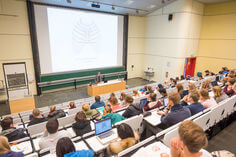Arbeitsgruppe Prof. Dr. Rohini Kuner
Kontakt

Pharmakologisches Institut
Universität Heidelberg
Im Neuenheimer Feld 366
D-69120 Heidelberg, Deutschland
Tel. +49-6221-54-16600
Fax +49-6221-54-16620
E-Mail: rohini.kuner(at)pharma.uni-heidelberg.de
Group leader in the Molecular Medicine Partnership Unit.
Forschung
Several chronic diseases are accompanied by strong, long-lasting pain. A majority of chronic pain diseases are not understood well as yet and cannot be controlled by conventional analgesics or non-pharmacological approaches. Therefore, there is a major need to develop novel therapeutic principles.
We aim at understanding molecular mechanisms underlying chronic pain resulting from long-lasting inflammation or cancer. A major focus is laid on addressing signalling mechanisms which underlie activity-dependent changes in primary sensory neurons transmitting pain (nociceptors) and their synapses in the spinal dorsal horn. Our current work spans molecular, genetic, behavioural, electrophysiological and imaging approaches in vitro as well as in vivo in rodent models of pathological pain.
Schmerzforscherin Rohini Kuner von der Uni Heidelberg erhält Leibniz-Preis
Areas of research include:
Mechanisms of plasticity at synapses between nociceptors and spinal neurons in inflammatory pain states
Plasticity of primary sensory neurons and of the synapses tey make with dorsal horn neurons is an important component of the cellular basis for the development and maintenance of chronic, pathogenic pain. Here, glutamate serves as the primary nociceptive neurotransmitter and activates several ionotropic and metabotropic receptors.
In several past projects, we have extensively characterized the role of spinal and thalamic NMDA receptors in cutaneous and visceral nociception in rat models using behavioural, pharmacological and electrophysiological methods. Recently, we have characterized the role of calcium-permeable AMPA receptors in nociception and chronic inflammatory pain using transgenic mouse models. Our results show that AMPA receptors are not mere mediators of fast excitatory neurotransmission in acute pain as previously thought, but are critically required for activity-induced potentiation in pathological states (Hartmann et al., Neuron 2004). Furthermore, we have recently reported that synaptic proteins of the Homer1 family, which interconnect metabotropic glutamate receptors (mGluR1/5) with intracellular calcium stores, are important modulators of inflammatory pain. We found that persistend nociceptive activity leads to the induction of the splice product Homer1a, which disrupts the mGluR1/5 signaling complex, and thereby plays a protective role against chronic pain (Tappe et al., Nature Medicine 2006).
A major interest in the lab is to study the functional significance of protein-protein interactions at synapses in the modulation of pain and other neurological functions. For example, we have addressed the heteromerization of GABAB receptor subunits (Kuner et al., Science 1999), identified and characterized novel protein-interactions of nitric oxide synthase (Dreyer et al. 2003, 2004), studied the role of interactions between Homer proteins and mGluR1/5 in the context of striatal function (Tappe et al., PNAS 2006) and addressed the role of proteins interacting with cannabinoid receptors in analgesic tolerance to cannabinoids (Tappe et al., J. Neuroscience 2007).
Expression of AAV-viruses expressing desired proteins, shRNAs or EGFP into the superficial laminae of L3-L5 spinal dorsal horn segments in mice in vivo
Several current projects are directed at elucidating novel mediators of synaptic plasticity at synapses between primary afferents and spinal neurons. In addition to transgenic approaches, the RNAi methodology and adeno-associated viruses (AAV) are our key tools for inducing molecular perturbations in the spinal cord. We use several models of inflammatory pain, including arthritis, to study alterations in pain behaviour in vivo. Furthermore, patch-clamp recordings and calcium imaging on spinal cord slices are employed for addressing potentiation of synaptic transmission. This work is partly supported by the Landesstiftung RNAi Program of Baden-Württemberg.
Group members involved: Anke Tappe-Theodor, Bettina Hartmann, Ceng Luo, Vijayan Gangadharan, Kiran Kumar Bali, Tamara Djuric, Hans-Joseph Wrede
Conditional deletion of genes encoding pain-relevant proteins in peripheral nociceptive neurons
We use the Cre/loxP system for conditional gene deletion in specific anatomical compartments of the pain pathway. For example, we have generated a mouse line which enables deletion of genes specifically in all nociceptive neurons of the dorsal root ganglia (DRG) and trigeminal ganglia without affecting gene expression in non-nociceptive neurons, the spinal cord, the brain or any other organs in the body (Agarwal et al., Genesis 2004). We have made these mice widely available to the pain community to enable nociceptor-specific deletion of a variety of pain-related genes. Recently, we have also developed viral-based or transgenic approaches to enable site-specific manipulation of genes in the spinal dorsal horn (Tappe et al., Nature Medicine 2006), in noradrenergic neurons of the Locus ceruleus (an important pain-modulatory center) or in subtypes of peripheral nociceptors.
Specific deletion of targeted proteins from nociceptive neurons in the dorsal root ganglia achieved using SNS-Cre mice
Several ongoing projects in the lab involve conditional deletion of receptors for neurotransmitters and neuromodulators such as cannabinoids, GABA, glutamate, endothelin-1 etc. or their signaling effectors such as G-proteins, protein kinases etc. selectively in nociceptive neurons. Currently, we are analysing the contribution of these mediators in inflammatory and neuropathic pain models using behavioural, electrophysiological and biochemical methods. For example, we found recently that a nociceptor-specific deletion of cannabinoid receptor 1 abrogates a large proportion of analgesia mediated by endocannabinoids and therapeutic cannabinoids. Our current focus on peripheral mechanisms of pain is based upon the hope of being able to target pain while circumventing centrally-mediated cognitive, motor and emotional side-effects. This work is partly funded by the Clinical Research Group 107 of the DFG.
Group members involved: Anke Tappe-Theodor, Bettina Hartmann, Ceng Luo, Gurpreet Kaur Satagopam, Peter Lepczynski, Hans-Joseph Wrede, Dunja Baumgärtl-Ahlert
Molecular mediators of pain caused by bone cancer and tumor-nerve interactions
Pain is one of the most severe and debilitating symptoms associated with various forms of cancer. About 30% of cancer patients suffer from excruciating pain during early stages of the disease and the proportion increases to 70% as the disease progresses.
Cancer pain is a unique and complex form of pain and represents a largely unexplored area. Cancer pain is distinguished by the unique aspect of tumor-nerve interactions, in particular, by mediators that are released from tumor cells or cancerous tissue in large quantities. These substances include glutamate, endothelins and a variety of growth factors and cytokines, several of which are capable of either directly activating pain-transducing nerve terminals and/or sensitising them against non-painful stimuli. In several projects, we are currently addressing pathophysiological changes induced by these agents in nerve endings in cancer-affected tissue using a broad base of molecular, pharmacological, electrophysiological and behavioural techniques. We use mouse models of bone cancer, which demonstrate the hallmark distinguishing features of pain associated with cancer of bone and connective tissues in humans. Transgenic and viral-based approaches are used to induce molecular perturbations in nerve endings and/or tumors and changes in pain and pain sensitization are addressed using behavioural assays. This work is partly funded by the Association for International Cancer Research, U.K.
Group members involved: Matthias Schweizerhof, Gurpreet Kaur Satagopam, Martina Kurejova, Dunja Baumgärtner-Ahlert
Collaborations: Don Simone (University of Minnesota, USA)
Molecular mediators of pain resulting from visceral disorders
Several visceral disorders are accompanied by chronic pain. For example, acute and chronic inflammation of the pancreas (pancreatitis), pancreatic cancer as well as inflammatory diseases of the gut, such as colitis, are associated with excruciating pain. The molecular mechanisms underlying visceral pain of this kind can diverge considerably from mechanisms of somatic pain and are very poorly understood so far.
In recent and on-going projects, we are addressing the endogenous control of visceral pain exerted by excitatory and inhibitory modulators such as glutamate, cannabinoids etc. using mouse models for the above diseases. For example, we found that the endocannabinoid system is an important regulator of pain and the disease pathology of pancreatitis in mouse models as well as human patients. Moreover, we observed that therapeutically applied cannabinoids ameliorate pain and disease pathology ini pancreatitis. This work is carried out in close collaboration with clinical departments of the university.
Group members involved: Danguole Sauliunaite
Collaborations: Christoph Michalski and Helmut Friess (Dept. of Surgery, University of Heidelberg), Federico Massa and Beat Lutz (University of Mainz)
Structural plasticity of nociceptive nerves in disease states
Structural plasticity of nerves in disease states is theme central to several of our projects. For example, in states of bone cancer, nociceptive terminals sprout in the epidermis of the skin adjoining the tumor. Similarly, in chronic pancreatitis as well as pancreas carcinoma, nerves innervating the pancreas demonstrate marked hypertrophy and sprouting. Because these structural changes are usually studied in post-mortem tissues, it is difficult to judge whether they are responsible for a range of sensory abnormalities or whether they are mere adaptive changes in occurring in response to the pathology and pain. In order to study the functional aspect of such structural changes, it is necessary to use imaging methods in living tissue. Towards this end, we have established a mouse line, called SNS-EGFP, expressing the live fluorescent label, EGFP solely in nociceptive fibers. Furthermore, in SST2-EGFP mice, an additional mouse line which we have generated, EGFP is expressed selectively in non-peptidergic nociceptors. Using such tools, we would like to address molecular mechanisms underlying dynamic changes in nociceptive terminals in disease states. This work is partly supported by the Chica and Heinz Schaller Stiftung.
Use of genetic indicator mice, e.g. SNS-EGFP, to image nociceptors in the skin specifically
Plexin-semaphorin interactions in neural development
Semaphorins and their receptors, plexins, are key regulators of neuronal migration and axonal pathfinding. In contrast to the well-characterized plexin-A family, very little is known about the expression and functions of plexin-B family proteins in the developing nervous system.
In the past, we have addressed the role of the plexin-B signaling complex in growth cone behaviour and nerve outgrowth in collaboration with the research group of Stefan Offermanns (Swiercz et al. 2002, 2004). Furthermore, our expression analysis revealed that plexin-B1 and plexin-B2 and their ligand semaphorin 4D (Sema4D) are expressed at key regions at critical time points during the development of the peripheral and central nervous system (Worzfeld et al., 2004). We have also addressed the role of plexin-B Sema4D interactions in epithelial-mesenchymal interactions during kidney development. Our current projects are focussed on characterizing mouse mutants lacking plexin-B1 or plexin-B2 for defects in the development of the peripheral and central nervous system.
Group members involved: Alexander Korostylev, Alexandra Hirschberg, Peter Vodrazka, Suhua Deng
Collaborations: Stefan Offermanns (Institute of Pharmacology, University of Heidelberg), Luca Tamagnone (University of Torino, Italy), Magdalena Götz (GSF, Munich)
Mitarbeiterinnen & Mitarbeiter
Liste
| Name | Position | Raum | Tel.: | |
| +49 (0)6221-54- | ||||
| Agarwal, Nitin | Dr. sc. nat. | 211 | 16608 | |
| Baumgartl-Ahlert, Dunja | TA | 201 | 16604 | |
| Briceno, Winder | IT Beauftragter | 209/310 | 16607/8644 | |
| Gan, Zheng | Ph.D. student | 224 | 16610 | |
| Gartner, Christl | Administrative Officer | 205 | 16601 | |
| Gehrig, Nadine | BT | 224 | 16612 | |
| Gupta, Pooja | Ph. D. | 202 | 16602 | |
| Janesch, Elisabeth | Lab assistant | 224 | 16611/86868 | |
| Kuner, Rohini | Prof. Dr. | 204 | 16600 | |
| La Porta, Carmen | Ph.D. | 209 | 16616 | |
| Liu, Sheng | Ph.D. student | 224 | 16613 | |
| Mandel, Nicolas | Ph.D. student | 224 | 16611 | |
| Meyer, Karin | MTA | 204 | 16611 | |
| Niemann, Anke | Biology lab assistant | 227 | 16613 | |
| Oswald, Manfred | Ph.D. | OMZ 224 | 8635 | |
| Seller, Anne | SFB- Coordinator | 202 | 16617 | |
| Simonetti, Manuela | Ph.D. | 212 | 16609 | |
| Speck, Julia | BTA | 224 | 16610 | |
| Tappe-Theodor, Anke | Dr. sc. hum. | 212 | 16609 | |
| Trutzel, Annette | Dr. rer. nat. | 203 | 16603 |




